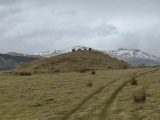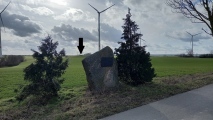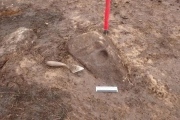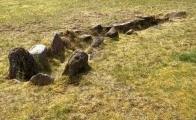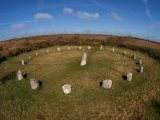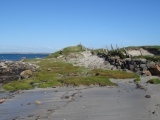Andy Burnham's Blog, page 112
March 10, 2023
Grave of Diarmid
A classic four poster it is unique in being situated on the top of a small knoll with virtually no flat room outside of the circle. Excavation showed the knoll to be a glacial deposit. There are excellent views down Glenshee. This circle does not appear in Burl's big black "Stone Circles of the British Isles" book but is described in the paperback "Guide to the Stone Circles of Britain, Ireland and Brittany" as Spittal of Glenshee.
Published on March 10, 2023 11:13
Carn Brea Enclosure
Finds from Carn Brea can be seen in the Cornwall County Museum in Truro.. Carn Brea is the best known of the tor enclosures and the one that has been subject to the largest campaign of investigation. The enclosure is built around the central and eastern summits of the 210m tall hill, and consists of up to seven circuits of orthostatic walling. Large amounts of Early Neolithic material culture, including ceramics, flint tools and axe heads, have been retrieved.
Published on March 10, 2023 03:38
March 9, 2023
Kultplatz auf dem Bollenberg
On the Bollenberg in Brandenburg, Germany, one of the highest elevations in the area was a neolithic cult place of the Globular Amphora culture (approx. 3000 BC) discovered in 1986. It was archaeologically examined until 1988. Among other things, two cattle were discovered, which were sacrificed sitting upright. Numerous shards of pottery and a fireplace bear witness to cultic activities during the sacrificial ceremony.
Published on March 09, 2023 10:27
Bowl Hill Circle
Purported to be a lost hill figure connected to the local Roman villa and mosaic. Identified by Graham Thomas as an ice age glacial feature. Tbe circle is seen middle and upper of the top photo, taken from the west facing east. It has thinned and the top is now largely missing. The text below is by Jo-Anne Wilder, from 3rd Stone Issue 23.
In 1987 the Gloucestershire Earth Mysteries group began a project to investigate the nature of a curious
circular mark on the steep slopes of Bowl Hill at Rodborough in Stroud. A local exponent of Arthurian matters proposed that this circle marked the spot of King Arthurs burial place based on writings from The Four Ancient Books of Wales and Geoffrey of Monmouths History of the Kings of
Britain. There is a legend that seven kings, Chieftains
or warriors are buried on a hillside somewhere
between London and Amberley.
In 1987 the Gloucestershire Earth Mysteries group began a project to investigate the nature of a curious
circular mark on the steep slopes of Bowl Hill at Rodborough in Stroud. A local exponent of Arthurian matters proposed that this circle marked the spot of King Arthurs burial place based on writings from The Four Ancient Books of Wales and Geoffrey of Monmouths History of the Kings of
Britain. There is a legend that seven kings, Chieftains
or warriors are buried on a hillside somewhere
between London and Amberley.
Published on March 09, 2023 05:23
March 8, 2023
Vindolanda Roman Fort
Prehistoric rock art, possibly phallic, discovered near Hadrian's Wall, more in the comments on our page. Vindolanda is a Roman fort associated with the defence of Hadrian's Wall; the site (or 'castra') is located in Northumberland, England immediately south of the present day Scottish border. The oldest extant writing by a Roman woman was found here. Vindolanda was established in approximately 80 AD, and.extensive ruined remains of many stone fort structures are extant to the present day. To the north of the site Hadrian's Wall looms as a massive green natural rampart, forming an atmospheric visual backdrop to Vindolanda.
Published on March 08, 2023 13:34
3rd Stone Issue 30, April-June 1998 for Free Download
For International Womens Day, Cheryl Straffon outlines an approach to ancient sites that is both practical and spiritual. Free PDF download, see page 10 and on .
In this Issue:
Cheryl Straffon - Does the Goddess Live Here?
Being There: Experiencing Ancient Sites
Nick Thorpe - The Archaeology of the Undead
Kenneth Brophy - This is Not Phenomenology
Caron Burt - Muddy Feet and Bright Blue Fingers
Jerry Wellard - Visions of Prehistory
K. M. Koppana - Stones, Trees and Rock Paintings
Aubrey Burl - Ever-Increasing Circles
Jeremy Harte - Show Me the Way to Go Home
D. J. Adams McGilp - Kilmartin House
Paul Newman - Panic! Panic!
Huw Sherlock - Time Team or Tame Team?
News & Shortcuts, Letters, Reviews and Classified
PDF e-magazine for free download: HI-RES LOW-RES
In this Issue:
Cheryl Straffon - Does the Goddess Live Here?
Being There: Experiencing Ancient Sites
Nick Thorpe - The Archaeology of the Undead
Kenneth Brophy - This is Not Phenomenology
Caron Burt - Muddy Feet and Bright Blue Fingers
Jerry Wellard - Visions of Prehistory
K. M. Koppana - Stones, Trees and Rock Paintings
Aubrey Burl - Ever-Increasing Circles
Jeremy Harte - Show Me the Way to Go Home
D. J. Adams McGilp - Kilmartin House
Paul Newman - Panic! Panic!
Huw Sherlock - Time Team or Tame Team?
News & Shortcuts, Letters, Reviews and Classified
PDF e-magazine for free download: HI-RES LOW-RES
Published on March 08, 2023 11:36
March 7, 2023
Auchrannie, Glen Cloy
This stone walled chamber associated with chambered tomb is just visible on grass verge in front of the Auchrannie leisure centre building in Brodick, Isle of Arran. The nearby souterrain and round house have been filled in and built over leaving nothing visible.
Published on March 07, 2023 09:38
March 6, 2023
Trygge Slot
In the middle of the island of Falster (Denmark) lay a mighty castle. It was built of earthen ramparts and palisades, and it utilized the natural defenses of the landscape. Archaeological excavations showed that the Trygge Slot was a significant castle in the Viking Age and the early Middle Ages from 800 1200AD/CE. Today, only low ramparts can be seen in the landscape by the lake Virket Sø, where Trygge Slot was a safe fortress for Falster's population. There was more than 500 meters from the embankment in the north to the embankment in the south. To the east, the Trygge Slot was protected by a high and steep slope down towards the lake and to the west by a swampy marsh and fortifications, which today are not visible in the landscape. In the middle of the nearly 80.000 square meter castle, a rampart cut across and divided the castle into two equal parts.
Published on March 06, 2023 13:33
March 5, 2023
Boscawen Un
Stone Circle in Cornwall more properly known as Boscawen-Ûn. The focus of fascination with this evocative circle is certainly the pillar located in the centre. Although it is a full 2.5m (8 feet) in length, it leans at such an angle that its tip is only 1.9m (6 feet 2 inches) above the ground. Excavation has revealed evidence that it was installed in the leaning position.
Published on March 05, 2023 07:06
March 4, 2023
Dun Ghott
The site is located on a promontory constituting part of the eastern coast of the Isle of Tiree. The 1972 report quoted on Canmore mentions that there are no remains of a structure here, but Beveridge (1903) reports distinguishable remains of a dun.
Published on March 04, 2023 09:51

